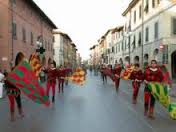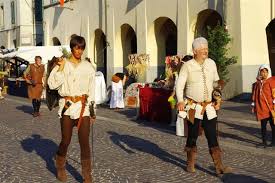The Battle of Càscina was an engagement between Pisan and Florentine troops on 28 July 1364 near Càscina, Italy. Florence's victory followed a recent defeat to Pisan forces .
John Hawkwood, was in command of the Pisan army, he wonted occupy the Valdinievole, Prato en route to Florence. .
Florence's defenses were organized by Enrico di Monforte. aided by Galeotto Malatesta.
Malatesta's forces engaged the Pisan contingent in the commune of San Savino to the southeast of Cascina, and gained a clear victory in the engagement.
Filippo Villani,reports in his cronicle : On 28 July, the Florentine army under the command of Galeotto Malatesta advanced to Cascina a few miles from Pisa. The road was open, but the temperature was unbearable. The armor of the warriors had become burning hot in the blazing sun; many removed their armor to bathe in the Arno river. The elderly Malatesta, convalescing from fever, succumbed to an afternoon nap, leaving the camp unguarded and the defense disorganized. Pisan spies reported the situation to their commander, the cunning John Hawkwood's (Giovanni l'Acuto)
Hawkwood's forces were outnumbered three to one, so he decided his best chance of victory was to launch a surprise attack while the enemy was unprepared.
At the time of the attack, the Pisan army's front line comprised a vanguard of Hawkwood's own English knights, followed by Pisan infantry and then by the bulk of the cavalry, temporarily dismounted. The rapid assault of the vanguard brought the English into the Florentine camp, with the improvised Florentine forward-defense quickly collapsing. However, the Florentines contained the impact, which failed to break the mass of defenders.
Hawkwood quickly realized that the surprise attack had failed and, to minimise losses to his company, withdrew the bulk of his Englishmen up to the walls of San Savino. The masses of Pisan foot-soldiers were then suddenly left to themselves, becoming the subject of violent counterattack by the Florentines. The surrounding countryside became the scene of a fierce of hunt of the broken body of Pisan infantrymen, now fugitive and defenseless. 
The next day the Pisans sought the dead and wounded scattered in the countryside. Many bodies were seen floating in the Arno driven by the current towards Pisa. The day had produced more than 1000 dead and 2000 prisoners. Foreigner prisoners were immediately released, but following custom, Pisan ones were taken to Florence.


